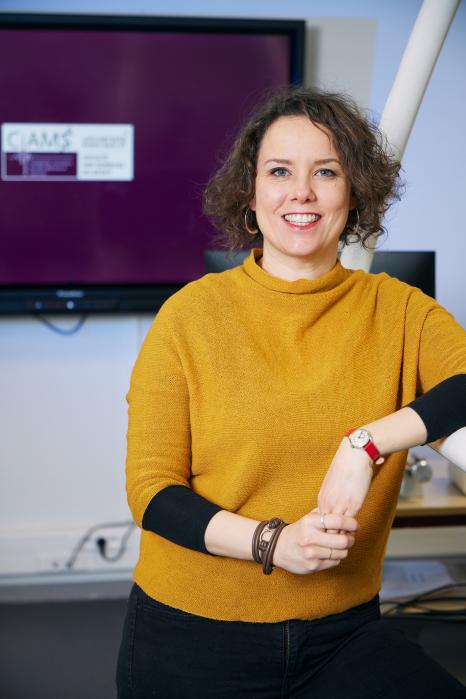
Marie Gernigon: understanding and optimising physical performance for all
Marie Gernigon is a lecturer at Université Paris-Saclay, at the Complexity, Innovation, Motor Skills and Sports Activities Laboratory (CIAMS - Univ. Paris-Saclay, Univ. d'Orléans) and Deputy Director of Education at the Graduate School Sport, Movement & Human Factors. As a specialist in exercise physiology and cardiovascular adaptations to exercise, she conducts research on both trained persons and persons with disabilities.
Marie Gernigon enrolled slightly by chance on a Bachelor's degree in Adapted Physical Activity (APA) at the Faculty of Sport Sciences of Université de Montpellier. In her third year, she did an internship at the Centre for Sport and Exercise Sciences at Anglia Ruskin University (Cambridge, UK). From 2008 to 2011, she was a research assistant, deepening her knowledge of exercise physiology and acquiring skills in both APA and performance with two researchers, one in France, the other in England. "My work was supervised by Alain Varray, an exercise physiologist at the Faculty of Sport Sciences of Montpellier, specialist in respiratory pathologies and president of the French Society of Adapted Physical Activity (AFAPA), and by Dan Gordon, a physiologist specialising in cardiorespiratory adaptations to exercise," says Marie Gernigon. During this experiment, she became interested in cardiorespiratory adaptations, maximum effort and factors limiting maximum performance.
GPS in the hospital
After a Master's degree in Rehabilitation through Adapted Physical Activities (RAPA), obtained at Université de Montpellier, and on her return from England, she joined the University Hospital Centre (CHU) of Angers as a hospital research engineer, in the department of Pierre Abraham. While in charge of clinical research protocols in the sport medicine unit, she decided to pursue her doctoral studies under the supervision of this cardiologist specialist. "My research involved characterising the gait of patients with Peripheral Arterial Disease (PAD). This peripheral vascular disease, which is linked to the development of atherosclerotic plaque in the legs, leads to a lack of oxygenated blood in the muscles that are effectors of walking, which causes tingling and severe pain that forces people to stop walking," explains Marie Gernigon.
Patients' maximum walking distance is decisive because it directs towards revascularisation. To characterise their walking, the team decided to compare the performance of the GPS to the gold-standard i.e., the treadmill test. "This simple method worked well and showed that it is possible to avoid having people who live a long way away come to the hospital to have a walking test," says Marie Gernigon. After her PhD thesis, defended at Université d’Angers in 2015, she returned to Montpellier where she obtained a position as a Temporary Teaching and Research Assistant (ATER) at the Faculty of Sport Sciences of Université de Montpellier. She was part of the EuroMov laboratory and remained there for two years until 2017, when she was recruited as a lecturer at the Faculty of Sport Sciences of Université Paris-Saclay and at the CIAMS laboratory.
Tourniquets to improve performance
Marie Gernigon is now co-supervising Julien Desanlis' PhD thesis together with François Cottin, a physiologist specialising in analysing the variability of cardiovascular signals and Dean of the Faculty of Sports Sciences. Her colleague Dan Gordon is also involved in the research. "We are currently witnessing a phenomenon that is becoming more and more widespread among athletes, in that they apply tourniquets during training or during the recovery phase. By exerting pressure that partially reduces blood flow, the idea is to stimulate angiogenesis, i.e. the factors that develop the vascular network. It would seem that this training method increases the oxygenation of the muscles involved in exercise. There is also an increase in strength and muscle mass. This can potentially be used post-surgery in athletes (reathletisation) or in training (performance optimisation/recovery)."
The objective of the research is therefore to truly measure the effects of this method. "During different exercise protocols, we study cardiac variability and vascular adaptations using boxes that measure oxygen perfusion by near-infrared spectrometry (NIRS) at the muscle level. We also observe oxygen consumption with a gas exchange analyser. The goal is to find out whether or not we are seeing an improvement in cardiovascular and respiratory status, and whether this is accompanied by an improvement in performance." A first publication was released in summer 2022.
Practical work in the laboratory
For Marie Gernigon, research and teaching are intimately linked. "You can't have good Master's and PhD students if you don't prepare them well from the first year of their degree." Responsible for the physiology courses and the "Adapted Physical Activity - Health BSc" degree, she was involved, with the teaching team, in the development and implementation of practical work in the laboratory from the second year of the degree. Students learn in small groups how to assess a participant during a rehabilitation programme. "We bring to life the concepts of physiology, biomechanics, motor control and psychology that are discussed in the lecture auditorium. To do this, we use field and laboratory approaches, such as gas exchange analysis with the characterisation of the ventilatory response. The groups study how an efficient body functions during exercise to better understand the adaptations of a deficient (pathological) body to exercise. In addition, this practical work confronts students with a wide range of professional realities and makes them understand the evaluations with and without laboratory equipment (cycle-ergometer, treadmill, inertial units, disability simulation kits, etc.)."
Deputy Director of Education at the Graduate School Sport, Movement & Human Factors since 2021, Marie Gernigon is responsible for adapting the Master's courses and their link to research. "We support innovative and cross-disciplinary teaching projects so that all courses and programmes can benefit from them." The Graduate School covers five Master's tracks for 500 students. Promoting mobility (EUGLOH, international course grants, Erasmus mobility) is another of her priorities. At the end of November 2022, student and teacher communities of the Master's in Ageing and Disability: Movement and Adaptation will set off for Stoke Mandeville (England), the cradle of the Paralympic movement, and three days of discussions around accessibility and adapted physical activity. "We're even going to play rugby in wheelchair with some former British Paralympic team members!" says the lecturer. After the Graduate School's last graduation ceremony in September 2022, other bonding events are planned for the 2022/2023 academic year, such as the annual workshop on the theme of physical activities and sports for all and the inclusion of all audiences.
"My role is to support my colleagues who know their networks and partners very well. We share the same motivation to train our students and see them succeed in their professional projects."

